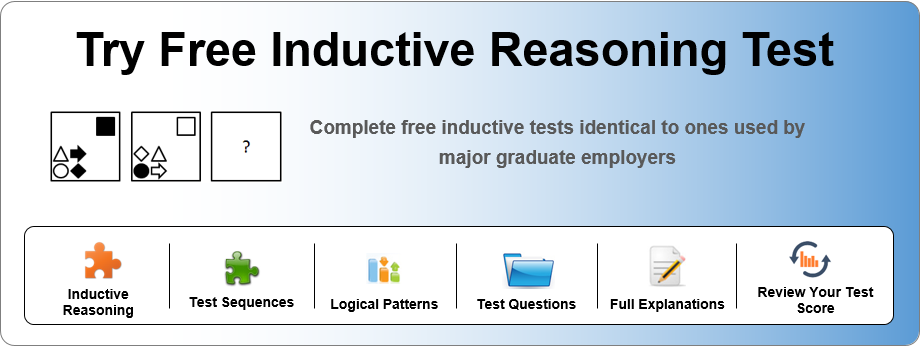Common Inductive Reasoning Test Patterns
To create patterns, rules or relationships in inductive reasoning sequences psychometric test publishers use wide range of constructs ranging from simple shapes to abstract symbols that may move, rotate, overlap, change their colour, shape or size or altogether change in quantities. In order to succeed in these assessments you need to be familiar and well aware of the most commonly used building blocks of inductive reasoning tests. The below sections, arranged according to difficulty level, will guide you through the question styles and format. Note that this is not an exhaustive list.
 |
One of the easiest types of series tends to be build around one-step patterns where the same change occurs in each box of the sequence. In such cases the rationale may be based around the number and type of items in each box. For example, you may encounter a question where you have to count number of objects in each square to find out how sequence develops. Click on the above link to see and learn how to approach such questions in your inductive reasoning tests.
 |
Further to the above some of the series may require you to count number of sides the particular shapes have answer the question. Moreover, they can be combined with different rules such as changing shading, size or positions of particular items. Find out more about such patterns from the above link and see real test examples.
A number of abstract psychometric test assessments comprise questions in which sequence is made up of moving or shifting objects. Usually, these patterns look rather chaotic nevertheless when carefully inspected governing rules may be easily spotted. Read more from the above tutorial what approach to take to correctly answer inductive reasoning test questions when items shift or follow specific movements along the row of boxes.
Often, inductive aptitude problems may comprise sequences where symbols transfer to different items. For example, a rule may exists where a triangle would change to square, square would change to circle and circle would be changed back to triangle. Click on the above link to see some test taking tips and strategies that demonstrate how to solve such challenges.
Usually, inductive reasoning assessments present with series where patterns are made of rotating symbols. For example, you may have diamond rotating 45 degrees clockwise whereas triangle rotating 135 degrees counter-clockwise. Usually, turning or spinning objects are easily spotted as they follow somewhat predictable way of spin. In the above link you can find out how to quickly work out problems that rotate or turn clockwise or counter-clockwise along the sequence.
Another frequent constructs of inductive reasoning tests are shapes that overlap, touch or cross in variety of different ways. For example, series may be based around number of intersections of particular shapes, the way in which the shapes cross or touch or alternatively the extent to which shapes or symbols overlap. Click on the above link to see some real sample questions of this type.
At times abstract selection exercises may constitute questions where patterns are based around the way in which the shapes cross or touch. A good example of such series can be seen from the above link.
It is not a secret that psychometric assessments are designed to distinguish the most able candidates and hence to succeed you have to develop successful test taking techniques. See some of the tricky questions that you may encounter in your inductive reasoning tests.

